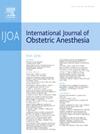Infrared thermographic assessment of cutaneous temperature changes during labour epidural analgesia initiation: an observational pilot study
IF 2.6
3区 医学
Q2 ANESTHESIOLOGY
引用次数: 0
Abstract
Background
Inadequate labour epidural analgesia within 30 to 45 minutes of insertion is typically considered primary epidural failure and deemed unsuccessful. Early prediction of analgesic success would have clinical benefit, enabling corrective interventions. Sympathectomy accompanying a successful epidural block can cause foot temperature changes. We sought to evaluate the relationship between foot temperature changes and successful epidural, defined as adequate analgesia in 45 minutes of epidural administration. For the purpose of this study, we defined primary epidural failure as inadequate analgesia within 45 minutes of administration.
Methods
Following ethical committee approval, this observational study was conducted in a tertiary level obstetric centre between January 2021 and March 2024. Patients attending for induction of labour were included: those with labour epidural analgesia comprised the epidural study group, and those without served as a control group. A FlirT540 infrared thermography camera was used to take bilateral foot images every 5 minutes for 30 minutes. Images were taken following epidural administration in the epidural group, and at any convenient time once in established labour in the control group. We studied temperature changes over time in the both groups, and compared the temperature changes in patients with successful and failed epidurals.
Results
Thirty-eight patients were included in the epidural group and 11 in the control group. Twenty-nine patients (76.3%) had successful analgesia and nine patients (23.7%) had primary epidural failure. Patients with successful analgesia had a statistically significant rise in temperature after 10 minutes. The maximum rate of increase was between 5 and 15 minutes and was 0.5 (0.1)°C per minute on both sides. Primary epidural failure was associated with minimal temperature changes, while all patients who had a 2°C rise in hallux temperature at 10 minutes had successful analgesia.
Conclusions
Sympathetic blockade associated with a successful analgesic epidural block produces cutaneous temperature elevation at the plantar surface of the hallux. These can be detected within 10 minutes of epidural administration and have a potential role in guiding timely troubleshooting of an unsuccessful epidural.
求助全文
约1分钟内获得全文
求助全文
来源期刊
CiteScore
4.70
自引率
7.10%
发文量
285
审稿时长
58 days
期刊介绍:
The International Journal of Obstetric Anesthesia is the only journal publishing original articles devoted exclusively to obstetric anesthesia and bringing together all three of its principal components; anesthesia care for operative delivery and the perioperative period, pain relief in labour and care of the critically ill obstetric patient.
• Original research (both clinical and laboratory), short reports and case reports will be considered.
• The journal also publishes invited review articles and debates on topical and controversial subjects in the area of obstetric anesthesia.
• Articles on related topics such as perinatal physiology and pharmacology and all subjects of importance to obstetric anaesthetists/anesthesiologists are also welcome.
The journal is peer-reviewed by international experts. Scholarship is stressed to include the focus on discovery, application of knowledge across fields, and informing the medical community. Through the peer-review process, we hope to attest to the quality of scholarships and guide the Journal to extend and transform knowledge in this important and expanding area.

 求助内容:
求助内容: 应助结果提醒方式:
应助结果提醒方式:


